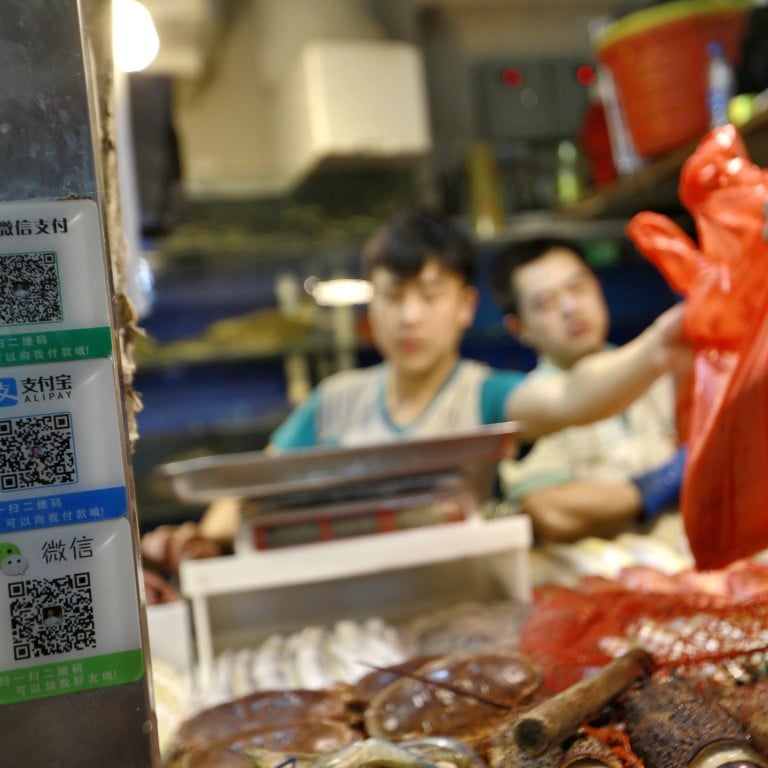
China’s digital currency tsar says e-pay platforms could bypass banks to give tourists access to cashless payment services
- Mu Changchun, the Chinese central bank’s foremost authority on digital currencies said the People’s Bank of China is ready to open its digital currency to visitors and rural residents without needing them to open bank accounts
- The move comes as Alipay and WeChat Pay account for 96 per cent of the country’s mobile payment, as the duo become “systemic significant” infrastructure, he said
China’s central bank, working on a plan to launch a digital version of the renminbi, said the virtual currency can be “decoupled” from the banking system to give visiting tourists a taste of the nation’s burgeoning cashless society.
The original construct of the proposed digital currency electronic payment (DCEP) system, which relies on licensed commercial banks to convert cash and coins in circulation into digital versions of the yuan, can be separated from the system for short-term visitors, said the director general at the Institute of Digital Currency at the People’s Bank of China. That would allow them to use the digital currency without first having to open a bank account with a Chinese bank, he said.
“The DCEP is loosely coupled with a traditional bank account,” said the central bank’s Mu Changchun, during the 2019 Hong Kong fintech Week conference. “Actually it could be decoupled from the traditional bank accounts. Thus, those who don’t have bank accounts in China can still open a digital wallet and enjoy mobile payment services in China.”

Ant’s Alipay ‘Tour Pass’ still requires a prepaid card from the Bank of Shanghai as the agent for transactions of between 100 yuan and up to 2,000 yuan each. Mu’s comments implied that in future, accounts at commercial banks can be completely cut out.
China received 30.5 million of foreign visitors in 2018, an increase of 4.7 per cent from the previous year. Alipay, which together with its rival third party payment provider Tencent’s WeChat Pay, account for as much as 96 per cent of nation’s mobile payment market.
Given their dominance, the two operators are “systemically significant infrastructure” operators in China, Mu said. It is precisely their dominance that prompted the central bank to commence research into its own digital currency – under the direction of former governor Zhou Xiaochuan, as early as 2014 – to provide a contingency payment option in the event of technical problems that harm the nation’s financial system.
Mu kept a tight lip on when the People’s Bank will roll out its digital currency. It is likely to be a nationwide roll-out that caters specifically to those underserved by the existing banking network, such as the estimated 800 million people classified as China’s rural population, Mu said.
The digital currency is likely to be used to support small retail transactions, and will be separate and distinct from the nation’s bank deposits, and won’t bear interest rates on any balance that the e-wallet keeps track on. It is unlikely to compete with either Alipay or WeChat Pay, Mu said.
“The two companies are providing a use case for end users,” Mu said. “We are not changing their use cases; their services will remain the same. In the future, I can only see synergy, not competition with them.”
Today, the payment services of both Alipay and WeChat Pay have evolved to cover various types of offline payment at merchants both within and outside China.
He said the other driver for the Chinese central bank on its digital currency is the increasing popularity of bitcoin, as the central bank responds to safeguard its sovereign currency.
At the panel discussion, Mu was also asked about the position on the Chinese monetary authority on Libra, which is the stable coin being mooted by Facebook.
Mu said that all the central bankers should put Libra under close supervision; and for China, the People’s Bank is “more than ready” to accommodate supervision on the Libra. He added that it is important though that in any such attempt to introduce Libra to China, the issuer must respect all the foreign exchange rules of the Chinese central bank and the State Administration of Foreign Exchange (SAFE).
For more insights into China tech, sign up for our tech newsletters, subscribe to our Inside China Tech podcast, and download the comprehensive 2019 China Internet Report. Also roam China Tech City, an award-winning interactive digital map at our sister site Abacus.


